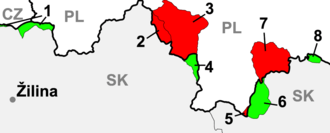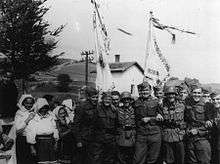Slovak invasion of Poland (1939)
| ||||||||||||||||||||||||||||||

The Slovak invasion of Poland occurred during Germany's invasion of Poland in September 1939. The recently created Slovak Republic joined the attack, and the Slovak Field Army Bernolák contributed over 50,000 soldiers in three divisions. As the main body of the Polish forces were engaged with the German armies farther north of the southern border, the Slovak invasion met only weak resistance and suffered minimal losses.
Background
March 14, 1939 saw the Slovak State established as a client state of Germany within the area of Slovakia. Prior to this, on November 2, 1938, a part of Slovakia containing a substantial Hungarian population (Slovakia having been part of the Kingdom of Hungary for centuries) was taken by the Hungarian Army as a result of the First Vienna Award of November 2, 1938. Small parts of these disputed areas with mixed Polish and Slovak inhabitants belonged to Germany and to Poland.
The official political pretext for the Slovak participation in the Polish Campaign was a disagreement over a small disputed area on the Poland-Slovakia border. Poland had appropriated this area on December 1, 1938, in the aftermath of the Munich Agreement of September 1938. In addition, some Polish politicians supported Hungary in their effort to include into their state parts inhabited mostly by Hungarians.
During secret discussions with the Germans on July 20–21, 1939, the Slovak government agreed to participate in Germany's planned attack on Poland. The Slovaks also agreed to allow Germany to use its territory as the staging area for its troops. On August 26, the Slovak Republic mobilized its armed forces and established a new field army, codenamed "Bernolák", which comprised 51,306 soldiers. Additionally, 160,000 reservists were called up, with 115,000 entering service until September 20, 1939.
Order of battle
The Bernolák army group was led by the Slovak Minister of Defense Ferdinand Čatloš, and had its initial headquarters in Spišská Nová Ves, though after September 8 this was moved to Solivar near Prešov. It consisted of:
- 1st infantry division "Jánošík" led by Anton Pulanich in sector Spišská Nová Ves – Prešov.
- 2nd infantry division "Škultéty" led by Alexander Čunderlík in sector Brezno – Poprad.
- 3rd infantry division "Rázus" led by Augustín Malár in sector east of High Tatra.
- A motorized unit "Kalinčiak" was created on September 5 but the campaign ended before it arrived on the front.
The group was part of the German Army Group South and was subordinated to the 14th Army led by Wilhelm List, contributing to the 14th Army's total of five infantry divisions, three mountain divisions, two tank divisions and one air force division. Bernolák's task was to prevent a Polish incursion into Slovakia and to support German troops.
Their opposition was the Polish Karpaty Army (Carpathian Army), which consisted of infantry units with some light artillery support and no tanks.
Campaign
The attack started on September 1, 1939 at 5:00 a.m. The 1st division occupied the village of Javorina and the town of Zakopane, then continued toward Nowy Targ, protecting the German 2nd Mountain Division from the left.[1]:50 During September 4–5, it engaged in fighting with regular Polish army units. On September 7 the division stopped its advance, 30 km inside Polish territory. Later, the division was pulled back, with one battalion remaining until September 29 to occupy Zakopane, Jurgów and Javorina.
The 2nd division was kept in reserve and participated only in mopping-up operations. In this it was supported by the Kalinčiak group. The 3rd division had to protect 170 km of the Slovak border between Stará Ľubovňa and the border with Hungary. It fought minor skirmishes, and after several days moved into Polish territory, ending its advance on September 11.
Two or three Slovak air squadrons (codenamed Ľalia, Lily) were used for reconnaissance, bombing and close support for German fighters. Two planes were lost (one to anti-aircraft fire, one to an accidental crash), and one Polish plane was shot down. Total Slovak infantry losses during the campaign were 37 dead, 114 wounded and 11 missing.
Aftermath
All Slovak units were pulled back until the end of September 1939. On October 5, a victorious military parade was held in Poprad. The mobilized units were gradually demobilized and the Army Group Bernolák was disbanded on October 7.
The Slovak Army took around 1,350 civilian prisoners in Poland. In February 1940, around 1,200 of these were handed to Germans, and some of the remainder to the Soviets. The rest were kept in a Slovak prison camp in Lešť.
All the disputed territory, whether part of Poland from 1920 or from 1938, was given to Slovakia (this was confirmed by a Slovak parliamentary resolution on December 22, 1939). Adolf Hitler's offer to annex Zakopane and some other parts of Poland was rejected by Slovak president Tiso, because Slovaks didn't live there. This arrangement lasted until 20 May 1945, when the border line was returned to its 1920 position.
Gallery
 Cheerful German and Slovak soldiers posing with Ukrainian civilians in Komańcza, Poland, in 1939
Cheerful German and Slovak soldiers posing with Ukrainian civilians in Komańcza, Poland, in 1939 Slovak soldiers of the 3rd Division posing before the statue of Kościuszko. General Ferdinand Čatloš (center) at Saint John Square in Sanok in September 1939
Slovak soldiers of the 3rd Division posing before the statue of Kościuszko. General Ferdinand Čatloš (center) at Saint John Square in Sanok in September 1939 Slovak State after the campaign
Slovak State after the campaign
See also
References
- ↑ S.J. Zaloga: Poland 1939, Oxford: Osprey Publishing Ltd., 2002. ISBN 9781841764085.
Further reading
- Charles K. Kliment and Břetislav Nakládal: Germany's First Ally, Schiffer Publishing, 1998, ISBN 0-7643-0589-1. The book covers the Slovak Armed Forces in World War II. 2003 Czech edition, ISBN 80-206-0596-7.
- Igor Baka: Slovensko vo vojne proti Poľsku v roku 1939 (Slovakia during the war against Poland in 1939), Vojenská história, 2005, No 3, pg 26 – 46.
- Igor Baka: Slovenská republika a nacistická agresia proti Poľsku (Slovak Republic and the Nazi Aggression Against Poland), Vojenský historický ústav, 2006, ISBN 978-80-89523-03-0, online.
External links
- Overview of the campaign (Czech)
- Map of the campaign (Czech) (archived link)
- Another overview, more military details (Czech)
